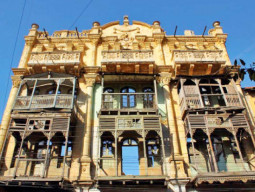
In our institutions of higher learning, there has been a welcome shift towards making students aware of the need to design and develop socially responsive projects.
The final year interior design students at the Indus Valley School of Arts and Architecture (IVS) have just completed a mini-thesis in which they have prepared a scale model of the Empress Market in Saddar, coming up with a set of recommendations for the conservation and rehabilitation of this iconic colonial market in Karachi.
Empress Market, constructed between 1884 and 1889, was named to commemorate the then Empress of India, Queen Victoria. The foundation stone of the market was laid by the then Governor of Bombay, James Ferguson, in 1884. Built to be visible from a distance, it was arranged around a large courtyard, with four galleries opening into the central space.

Before choosing Empress Market as the focus of their project, the students, under the supervision of IVS teacher Sibte Sajjad, also considered alternative design options for pedestrian bridges and other public facilities. They decided, however, that reviving Empress Market was a unique challenge with opportunities to work with a heritage space that, to this day, has extensive public usage — even though they thought that the way it is being used today is damaging the structure, leaving it in desperate need of being utilised in an alternative way that is compatible with its long-term conservation.
The students began with extensive research and review of all available historical records, studies and renovation, planning and functional use recommendations for the market. Apart from working to develop design options for conservation and viable public use, they also took the challenging decision to create a precise scale model of Empress Market.
This task ran into trouble from the very start, since the original architectural designs and planning documents were not available. Some drawings and information were obtained from publications by architects Yasmeen Lari and Arif Hasan, as well as from the archive cell of the architecture and planning department of the NED University, but they were insufficient for the precise requirements of the proposed model.

So the students took matters into their own hands, spending a week photographing and measuring every window, door and other architectural feature of Empress Market. The photographs also served another purpose — much of the market’s original ambiance and features have been lost over time, so the students tried to map the changes. For example, a fire destroyed at least 46 shops and damaged 62 others in the market in 2011. The students, therefore, did their best to create a clearer picture by documenting whatever original data could be accessed for that part of the market. They labelled, digitised and categorised the data, marking columns and wall details as primary data, windows and doors as secondary data and intricate carvings and woodwork as tertiary data.
The residents of the area as well as the shop owners, vendors and customers also took a keen interest in the project, sharing their experiences about how the market had changed over time and expressing a desire for improvement.
The team then came up with ways to conserve and revive the space. One of their recommendations was to create an exhibition space, with different sections capturing a different era in the city’s history. They also recommended the creation of an archive or library and proposed ways to improve the market’s present use.
Such contributions need to be given their due merit and consideration in efforts to preserve Karachi’s rich historical legacy and to turn our architectural and heritage sites into viable, vibrant public spaces.
Farhan Anwar is an urban planner who runs a non-profit organisation based in Karachi focusing on urban sustainability issues
THE PROJECT TEAM
The brains behind the work
Sidra Hasan Khan
Hadiyaa Rauf Khan
Fatima Nayab
Iqra Aziz
Kiran Atta Khan
Sarah Tanveer Ahmed
Maria Shabbir Hassain
Farhan Ali
Kiran Jatoi
Muhammad Abrar
Maha Nadeem
Shaheera Nadeem
Muhammad Bilal
Published in The Express Tribune, June 1st, 2015.















































COMMENTS (2)
Comments are moderated and generally will be posted if they are on-topic and not abusive.
For more information, please see our Comments FAQ